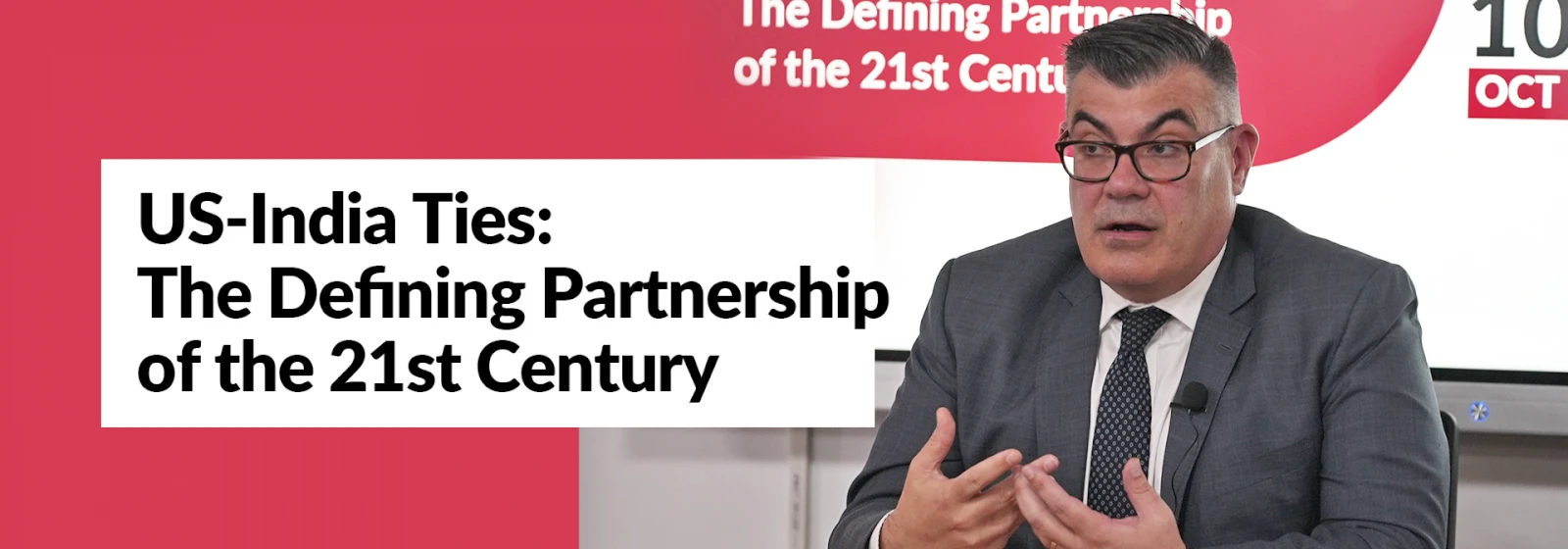US-India Ties: The Defining Partnership of the 21st Century
Discerning a world marred by discontinuities, breaks and ruptures in the motivations of state actors, relationships with their counterparts and positionality in the system of states remains a challenge for the observer.
To make sense of such changes in the tremendously consequential previous decade (2014-2024), the Department of International Relations and Governance Studies had the privilege to host Graham Mayer, Minister Counselor for Political Affairs at the US Embassy, New Delhi. The talk was the third edition of Shiv Nadar University’s talk series ‘From the Diplomat’s Perch.’
As Mayer spelt out the decadal shifts and geopolitical churnings, his central thesis was that Indo-American relations have emerged as the defining partnership from the process. Such an inference was to be arrived at, in a stepwise manner, whereby during the last decade – the world had changed, the United States had changed, India had changed, and as a result the United States-India relation had changed.
Beginning with a systemic level of analysis, Mayer observed that the year 2014 was still a time when the United Nations functioned admirably. Although the People’s Republic of China had begun to theoretically articulate its claim on the South China Sea, the South Asian neighbourhood was still stable.
This could be contrasted with the multifarious geopolitical challenges induced by the COVID-19 pandemic, compounded with the People’s Republic of China operating as a revisionist power in an unhelpful and disruptive manner. The year 2014 was also a period when the United States was still in - what Mayer referred to as – the ‘Francis Fukuyama hangover’.
This meant the continuance of a post-Cold War orientation that the United States could lead anywhere and on everything. However, the present moment was starkly different with the American foreign policy establishment imputing centrality to its alliances and strategic partnerships. There were some significant changes even in the Indian diplomatic trajectory. While the year 2014 witnessed India gradually venturing into Act East Policy from the Look East Policy, the present moment captured New Delhi’s much enhanced geopolitical heft, especially after its G20 Presidency.
Coming the trajectory of the Indo-American relations, Mayer posited how the initial uncertainty and mistrust between the two nations have given way to high-level agreement and exchanges, greater strategic convergence and sustained cooperation. This could be vindicated by the Presidential characterisation of India as the most important country for the United States. Invoking Ambassador Eric Garcetti, Mayer noted that the Indo-American partnership was to be built on a 4P formulation – peace, prosperity, planet and people.
Reflecting on these dimensions, Mayer advanced how the two nations are currently sharing great military proximity through different joint exercises – the Malabar Naval Exercise as a case in point. Their mutual trust gets reaffirmed through the fact that the American navy ships are now routinely docked at Indian shipyards like the ones in Tamil Nadu for the purpose of maintenance and repair. Moving on to the dimension of prosperity, Mayer averred that the bilateral trade between the two nations is currently poised at about 200 billion dollars. Moreover, the decision to shift the manufacturing centres of next-generation fighter engines to India as well as tapping into its critical and emerging technologies for semiconductor production point to evolving geoeconomic convergence between the two nations. Similar collaborations in the fields of Artificial Intelligence, Quantum Computing and Machine Learning vindicate the mutual spirit of discovery embedded in the discourses of both these states. Nevertheless, it was submitted that there still existed some untapped opportunities in this domain, with the taxation regimes acting as major impediments to further prosperity.
Mayer captured that the planetary dimension of the Indo-American collaboration, especially through solar power architecture, in sharp contrast to many other nations which do not share similar urgency regarding climate change. Finally, people-to-people engagement constitute a critical dimension of the relationship, especially through the educational exchanges between the students. Herein, it became instructive to note that Indian students had already overtaken Chinese students with respect to their presence in American institutions.
Moreover, the vibrant Indian diaspora is to be seen as an equally salient component of the people-to-people engagement between the two nations. Collating the aforementioned facets of the relationship, Mayer closed his discussion with an observation and a prognosis. The former pointed to the bipartisan consensus in the American strategic community over the centrality of the Indo- American relation. The latter was a definitive proclamation that India would become a superpower, possessing more heft than China, by the second half of this century.
The talk was followed by some extremely insightful interventions made by the audience present. The reflections pertained to the broader perception of America towards a geopolitically resurgent New Delhi, the evolving scope of people-to-people relations, the balancing act between the geopolitical dimensions and the developmental dimensions of QUAD, the extant global crises and its ramifications on the Indo-American relations and the question of technology and knowledge transfer to developing nations like India.
Graham Mayer flagged some important issues in the discussion that followed. He remarked that there were no American apprehensions at the prospect of India gaining geopolitical heft because of the democratic and accountable nature of the political system of the latter – which would precisely preclude any revisionist ambition a la China.
Mayer was particularly impressed about the evolution of the Quadrilateral Security, especially its fast-tracking from the secretary-level talks in 2017 to leader-level summits in 2021. Judging from the current trends Mayer remained confident of a QUAD Secretariat within the next decade. Mayer was quite succinct while reflecting on the global perception and the fallouts of the Israel-Palestine quagmire, assigning security and human casualties as the most compelling factors from the American prism.
Mayer concluded on an optimistic note over the question of technology transfer, positing that the stringent regulations were surely to recede in the time to come, with the G20 Summit having made significant forays into this question.
